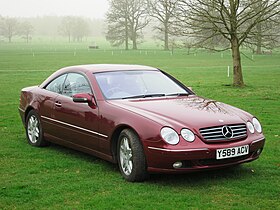| Mercedes-Benz CL (C215) | |
|---|---|
 | |
| Overview | |
| Manufacturer | DaimlerChrysler |
| Production | June 1998[1] – February 2006 |
| Assembly | Germany: Sindelfingen |
| Designer |
|
| Body and chassis | |
| Class | Grand tourer (S) |
| Body style | 2-door coupé |
| Layout | Front-engine, rear-wheel-drive |
| Related | Mercedes-Benz S-Class (W220) |
| Powertrain | |
| Engine |
|
| Transmission | |
| Dimensions | |
| Wheelbase | 2,885 mm (113.6 in) |
| Length | 4,993 mm (196.6 in) |
| Width | 1,857 mm (73.1 in) |
| Height | 1,390–1,408 mm (54.7–55.4 in) |
| Curb weight | 1,865–2,155 kg (4,112–4,751 lb)[2] |
| Chronology | |
| Predecessor | Mercedes-Benz C140 |
| Successor | Mercedes-Benz C216 |
The second generation of the CL-Class used the C215-chassis designation and was manufactured and marketed by German automaker Mercedes from 1998–2006 as the company's flagship model, a two-door, four-passenger coupé.[3]
Based on the 1998–2005 W220 S-Class, it uses an 8-inch (203 mm) shorter wheelbase. Its unique unibody construction used a steel floor pan, chassis rails and A pillars along with a bonded aluminium roof and rear wing sections, magnesium door frames and composite plastic used for the boot/trunk and front wings.
Sales in Germany started in August 1999 for the CL 500 V8 model.
The exterior design and active suspension for the C215 were previewed by the Mercedes-Benz F200 concept in 1996.[4]
Model variants included the:
- V8-powered CL 500
- V8-powered CL 55 AMG (later powered by a supercharged V8)
- V12-powered CL 600 (2000-2002)
- 5.5-litre V12 Bi-Turbo CL 600 (2003-2006)
- limited production CL 63 AMG (26 examples only)
- limited-edition 2000 CL 55 AMG F1 Edition (55 examples only)
- limited production (777 total) 6.0-litre V12 Bi-Turbo CL 65 AMG (2004-2006)
The car has a drag coefficient of Cd=0.28[5] for regular models and 0.29 for the AMG models.
- ^ "CL 500 / C 215 E 50, 1999 - 2002". mercedes-benz-publicarchive.com. Retrieved 10 December 2023.
- ^ "215 series CL-Class Coupés". mercedes-benz-publicarchive.com. Retrieved 5 September 2018.
- ^ "215 series CL Coupés, 1999 - 2002". mercedes-benz-publicarchive.com. Retrieved 28 November 2023.
- ^ "Joystick-Driven Mercedes F200 Imagination Spotted With Its Many Screens". motor1.com. Retrieved 28 November 2023.
- ^ "Technical highlights of the CL-Class and its predecessor series". media.daimler.com. Retrieved 30 August 2019.